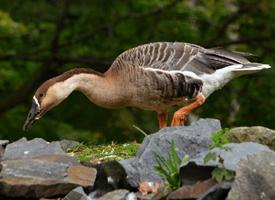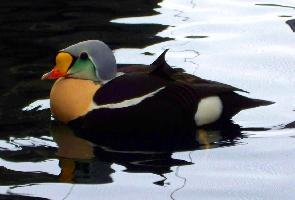
Descrierea animalului
The Brant, scientifically known as Branta bernicla, is a medium-sized, migratory goose that belongs to the family Anatidae, which includes other waterfowl such as ducks and swans. This species is notable for its remarkable adaptability to various habitats and its extensive migratory patterns, which have fascinated birdwatchers and researchers alike.Characteristically, the Brant goose exhibits a compact body shape with a relatively short neck and a small, triangular bill, which distinguishes it from other geese. Adult Brants generally display a predominantly dark plumage, which is finely barred and speckled with light gray on the flanks. One of the most striking features of the Brant is its black head, which is neatly contrasted by a white patch on either side of the neck. This distinctive marking is often referred to as a "necklace" and varies in thickness among individuals.
The Brant is divided into three subspecies, each adapted to slightly different habitats and regions. These include the Dark-bellied Brant (Branta bernicla bernicla), the Light-bellied Brant (Branta bernicla hrota), and the Black Brant (Branta bernicla nigricans). The differences among these subspecies are primarily in the coloration of the belly and the migration routes they follow.
The natural habitats of the Brant are coastal marshes, estuaries, and tundra regions, where they breed in the summer months. During the breeding season, Brants are known for their fidelity to nesting sites, often returning to the same location year after year. Their nests are simple depressions on the ground, lined with plant material and down feathers, where the female lays a clutch of 3-5 eggs.
As herbivores, Brants have a diet that primarily consists of aquatic vegetation, grasses, and seaweeds. During the winter, they can often be found in large flocks grazing on eelgrass (Zostera spp.) and sea lettuce (Ulva spp.) in coastal waters, displaying their remarkable ability to digest cellulose, a trait not common to all geese.
Migration is a critical component of the Brant's life cycle. They undertake long-distance flights to reach their wintering grounds, which can be as far south as Baja California in the Pacific and the southern United States on the Atlantic coast. During these migrations, Brants demonstrate incredible endurance and navigational skills, often flying at high altitudes to cover vast distances.
The Brant plays a significant role in the ecosystems they inhabit, contributing to the dispersal of plant seeds and serving as prey for predators such as foxes and large birds of prey. Despite facing threats from habitat loss, pollution, and hunting, Brant populations have remained relatively stable, thanks in part to conservation efforts and international agreements that protect migratory birds.
In conclusion, the Brant is a fascinating and resilient species, emblematic of the challenges and triumphs of migratory waterfowl. Its adaptability, distinctive appearance, and complex behaviors continue to captivate those who have the opportunity to observe these remarkable birds in their natural habitats.
Animale similare
Fotografii noi cu animale
Top 10 animale
- Dolphin gull (Leucophaeus scoresbii)
- Diana monkey (Cercopithecus diana)
- Moustached guenon (Cercopithecus cephus)
- Galápagos tortoise (Geochelone nigra complex)
- Japanese macaque (Macaca fuscata)
- Stone loach (Barbatula barbatula)
- Russian tortoise (Testudo horsfieldii)
- Greek tortoise (Testudo graeca)
- Common flying dragon (Draco volans)
- Vendace (Coregonus albula)


